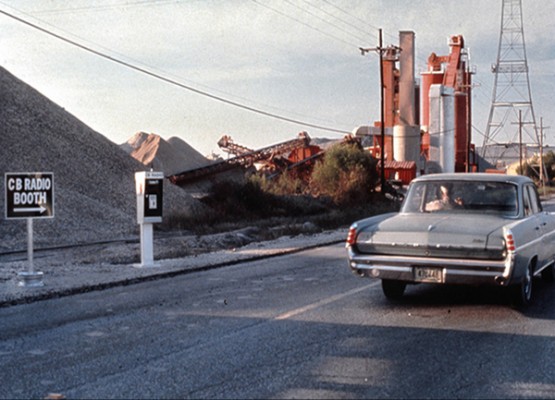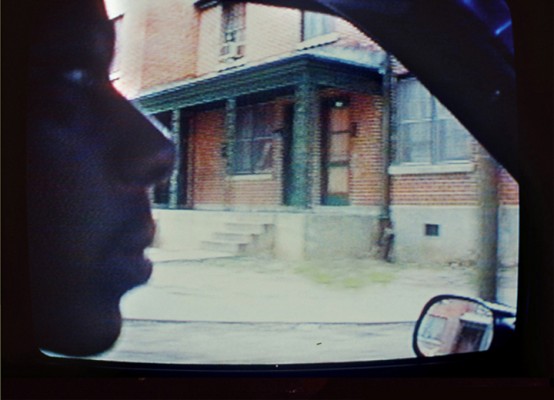Looking Back: Dawn DeDeaux

Dawn DeDeaux, CB Radio Booths, 1975-1976. Installation of nine CB radio booths at various locations. Courtesy the artist and Arthur Roger Gallery, New Orleans.
Dawn DeDeaux identifies herself first as a conceptual artist. Over the last four decades she’s worked with photography, video, sculpture, sound, and performance. In 1976, she entered and won the Louisiana Demolition Derby as the only female contestant. She’s sometimes been criticized for not working consistently in one medium, not having a cohesive and distinct “style.” Perhaps those critics forget that “conceptual artist” used to mean something. DeDeaux chooses the materials she thinks best convey her ideas. To really appreciate her ability to match medium to subject is to understand it as an act of artistic agency, rather than a fault.
If there is one touchstone of DeDeaux’s varied practice—a way of potentially determining the efficacy of her work even today—it is participation, a concern that can be traced to her earliest works. In 1975, DeDeaux conceived the project CB Radio Booths as an intersection of her interests in mass communication and her desire to break down self-imposed barriers of prejudice. At the forefront of engaging audiences outside the constructs of the art establishment, the result was nine functioning stainless steel radio booths stationed across southern Louisiana. Anyone could pick up the receiver and start talking—and folks did. The Federal Communications Commission granted DeDeaux a special channel and, with headquarters located at the top of One Shell Square, a purely egalitarian means of communication was born—the original “chat room.” Different than a telephone call, which has the element of purpose to it, on the CB radio participants didn’t know whom they were calling. The person waiting on the other end could be of a completely different socioeconomic status, race, religion, or political affiliation. DeDeaux discovered over the three-month run that the project spawned new conventions of language in these collisions of culture, similar to the internet slang and text message abbreviations of today. The booths also gave rise to new identities, as users gave themselves nicknames. New relationships formed and some participants even arranged in-person meetings, heralding the possibilities of random human communication that would later be fully realized in the advent of the internet age.[i]
At the time she was creating her CB Radio Booths the art world was still reeling from Fluxus and its subsequent movements. DeDeaux was walking amongst giants such as Nam June Paik, who also prophesied the era of mass communication and the far-reaching influence of information technologies. Theorists questioned the idea of originality and warned of the dissolution of reality. Baudrillard wrote that reproductive media was responsible for creating a new “hyperrealism” that replaced what we previously conceived of as reality. Starting with Realism and passing through the meatgrinders of Surrealism and the ubiquity of TV, reality was increasingly threatened by a spiraling simulacrum of its former self. No more dreams, no more fantasy—just an abstract world of repetition where everything might be imaginary.
DeDeaux continued to act as a selector in this brave new world, taking moments from life, stripping them down to their basic elements, and forcing us, the viewers, to pay attention to what we normally would not. For her 1988 video installation, Drive By Shooting, the artist spliced together footage taken while cruising the streets with two notorious New Orleans gang members with later documentation when she happened upon a victim of a drive-by incident just as the police were arriving.[ii] The vantage point of the video is from inside the car with the boys, blurring the lines between perpetrator, victim, participant, and observer. Were we viewers to witness this event in our own neighborhoods, we might be consumed by fear and horror. In the safe position of gallery voyeur sitting in an easy chair, however, it takes on the feeling of an imaginary experience with roots firmly grounded in more reality than we might care to admit.
That’s exactly where DeDeaux’s mastery of media excels. In selecting the right topic and tool for exposure she can say: Look at this, no, really look. This is not imaginary; this is reality. This is your reality whether you like it or not. It’s happening right here in our town, so consider it. Consider talking to a stranger, consider what life might be like for someone else, and—increasingly in her latest works—consider the ramifications of disaster.

Dawn DeDeaux, Drive By Shooting, 1988. Video still frame. Courtesy the artist and Arthur Roger Gallery, New Orleans.
[i] Through promotional materials, participants were invited to the grand opening of the Contemporary Arts Center in New Orleans when it exhibited four of the CB Radio Booths in 1976. Many more participants met face-to-face at that time.
[ii] DeDeaux met Paul and Wayne Hardy through her work with incarcerated youth. They were major figures in the artist’s 1992-1993 touring exhibition “Soul Shadows: Urban Warrior Myths.” In connection with a capital murder investigation, the FBI seized the artist's raw footage of the Hardy brothers in October of 1995. Wayne Hardy was killed in a drive-by shooting that same year, while his brother Paul was convicted of murder and given the death penalty.
Editor's Note
This essay on two of Dawn DeDeaux’s seminal projects was originally published on the occasion of “Dawn DeDeaux: Unseen,” on view March 12 – April 16, 2011 at Arthur Roger Gallery in New Orleans.



